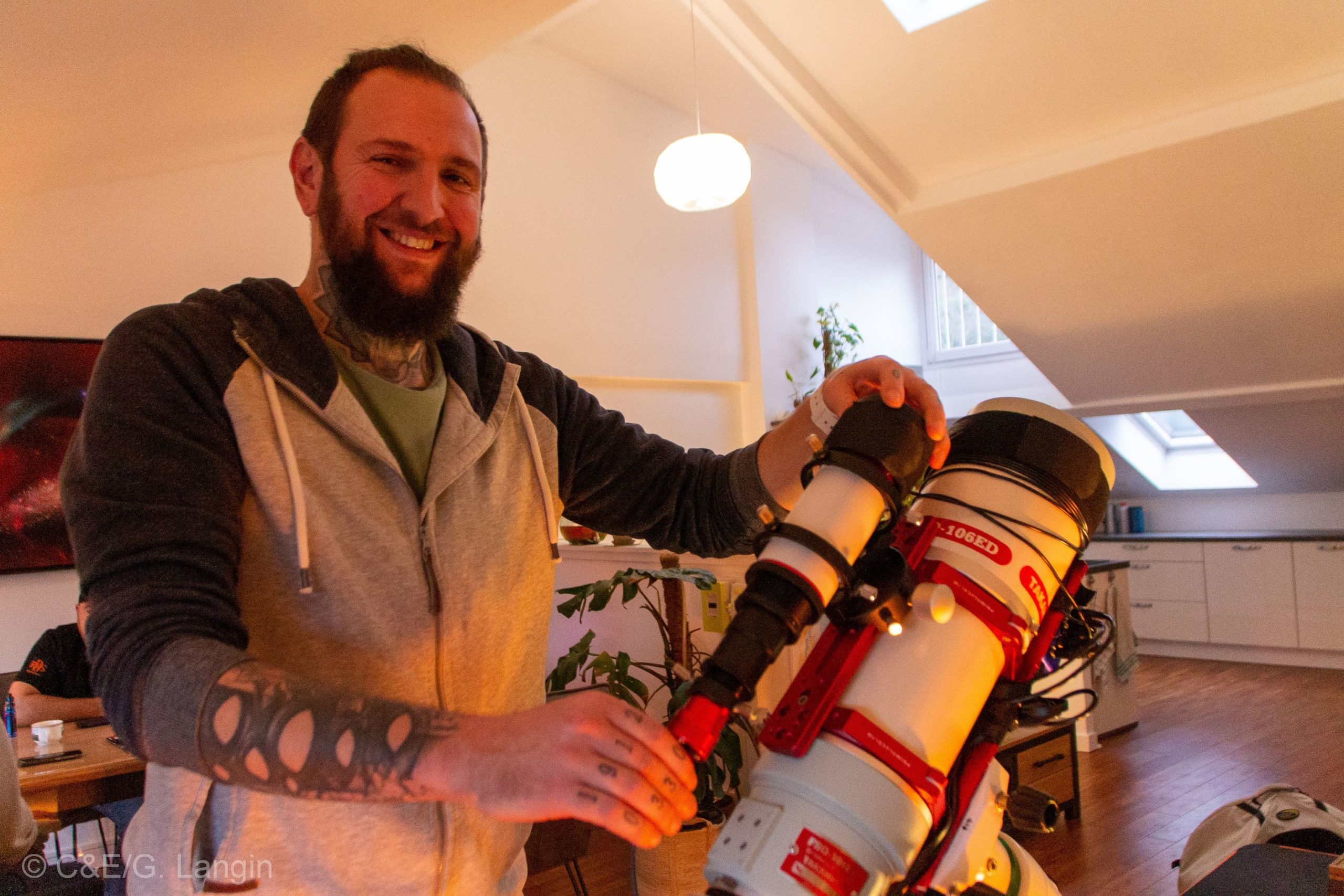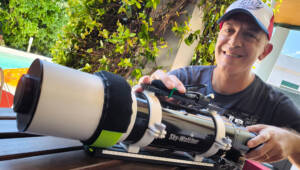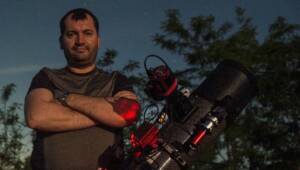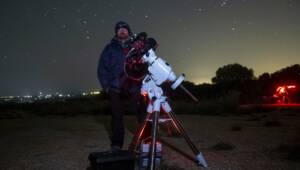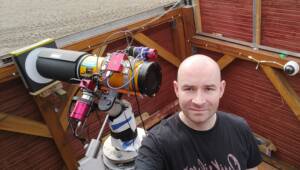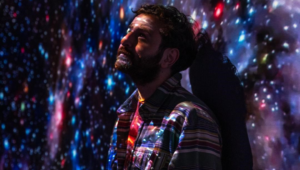Hello Yann, thanks for accepting our interview invitation. Congratulations on winning the ASIWEEK competition in week #32/2023!
Q1: At first, congratulation that your nice image won #ASIWEEK. This is actually your second interview with us, can you introduce yourself to new readers?
Hi everyone. My name is Yann, I’m 37 and I live in Lorraine, France. I’ve been practicing astrophotography for 3 years now. Living in an apartment in the city, I’ve spent the last two years traveling thousands of kilometers to shoot.

I’m a team member of Team Stellae Orentis (https://www.facebook.com/TeamStellaeOrientis).
Now my main setup is in the Atlaskies Observatory in the Atlas Mountains in Morocco, and I’m part of the Atlaskies Team (https://www.facebook.com/atlaskies) with whom we practice astrophotography and search for new nebulae. Meanwhile, I continue to practice as a nomad with a light setup to continue sharing beautiful starry nights with my friends.

Q2: What is the type of target you shoot most often? Why?
I don’t really have a favorite type of target. I let myself be carried away by my desires, and I like to make targets that are not often pictured, as this allows me to discover them and help others discover them.
I also find it more exciting for the processing, because you’re more likely to be surprised by the result over the course of a few sessions, compared with a target for which you already know what you’re going to get.
I also really like wide fields, which are full of detail and in which you can wander around to discover all their secrets.

Q3: How long is the cycle time for one of your photos to be completed? Which part of the process do you find the most challenging?
I never set myself a target for exposure time, or a schedule for a project. After each session, I quickly process all the data I have. If I’m happy with the signal-to-noise ratio, I stop, and if not, I continue until I’m satisfied with the raw signal.
Before, the biggest challenge for me was the physical and mental energy I had to put into each image, sometimes travelling 5,000km over 20 nights to get a satisfactory result.
Now that I’m part of Team Atlaskies, the challenge is to produce images that live up to the exceptional conditions we have over there.

Q4: Can you tell us about the winning photo?
As my main setup is now in the Atlaskies Observatory, I’m thinking about a small nomadic setup that’s very easy to set up.
Nicolas, a good friend to me, lent me his Star Adventurer GTI, his ASIAIR and these Baader H and O filters so that I could install my 2600MC and Sigma Art 135mm.
The immense hydrogen-red nebulosity are a bit like a jewel box showcasing numerous gems such as the supernova remnant W63, emission nebulae (like the Crescent Nebula NGC 6888, the Tulip Nebula SH2-101 for the best known) and the star Wolf Rayet 134.
I’m really delighted with this ultra-efficient and quick setup. It’s great to be able to indulge in a quick image. By opening the sigma at F2, I can quickly get a lot of signal, and all I have to do is shoot the stars apart at F8 to get great sharpness and these beautiful diffraction on big stars. I just add the Oiii layers of my previous data shooted in Atlaskies Observatory to get better data on the Oiii objects of this image. And what a pleasure to be able to hit the road again and spend nights under the stars with friends.

Q5: What are the advantages of the astrophotography method of creating a mosaic? What kind of shooting targets are suitable?
For me, the advantage is to be able to produce a high-resolution image that you can zoom in on and take a trip inside. There’s much more finesse and detail in a mosaic produced with a longer focal length than in an image containing the same field with a shorter focal length.
All targets can be shot in mosaics, depending on the focal length used. You could, for example, mosaic the whole Cygnus with a focal length like mine, but you could also imagine mosaicing a much smaller object with a larger focal length.

Q6: How do you normally do post-processing? Would you like to share with us your workflow?
It would take too long to explain everything in detail, but I think my general process is the same as that of many other astrophotographers.
I pre-process each session and store the images.
Once I’ve got everything I align and stack all the data.
Then I process all the layers separately in starless.
Then I process the RGB stars separately and reintegrate them into the mix of the other layers.
Then I take care of the cosmetics, contrast management, saturation, etc.
I attach great importance to respecting the signal and not adding or creating anything. I think there are as many processing methods as there are astrophotographers, and no one way is better than another. The important thing, in my opinion, is to do what you like and how you like to do it, so that, in the end, you can be proud to share your image.
Q7: What gear do you use? Any pictures of them?
I use a Takahashi FSQ106 EDX4 on a Sky-Watcher Eq6R Pro mount.
I mainly use the ASI 2600MM Pro coupled with Antlia 3nm SHOLRGB filters.

I also like to use the sigma Art 135mm on the 2600MC Pro with Baader filters for fast setup at F2 on an Sky-Watcher Star Adventurer GTi.

Q8: What changes have you made in astrophotography based on your practical experience?
I used to get excited about publishing an image. As a result, I didn’t pose long enough, and I didn’t take a step back from the processing.
Now I prefer to publish fewer images, but I want them to be more polished. Sometimes I spend 2 months on a single image, to shoot enough data to be able to process it properly. But also to take a step back from the processing.
I usually process a first version and then wait for the next day without looking at the image. The next day, with a fresh look, I know whether I’m on the right track or whether I need to start all over again.

Q9: What do you consider to be your highlight moment in astrophotography?
It goes without saying that the discovery of M31’s Oiii arc was an emotional adventure for the whole team. But the most beautiful and powerful moment will forever remain the project around my mom’s nebula.
My mom passed away before I discovered astronomy, so I was never able to share it with her. But I know that she would have been my first supporter and that I could have shared this adventure with her. So to be able to shoot an unknown nebula and give it its name will remain the most beautiful tribute I could have paid her.
I’d like to thank Xavier and Marcel from Team StDr for offering me this wonderful and exceptional opportunity by exceptionally allowing me to name their StDr Object 32 discovery after my mom: The Joëlle’s Nebula.


Q10: How do you balance your hobby of astrophotography with your work?
I’m self-employed and work from home, so it’s pretty straightforward for me to be able to balance astronomy and work.
I used to go out shooting and sleep under the stars, then come home in the morning and go straight to work. Now, with the Atlaskies observatory, it’s much easier.
I get the data in the morning, pre-process it and store it. And I no longer have to drive, sleep under the stars and be tired during the day. This solution allows me to live this passion to the full in the best possible conditions, without it having too great an impact on my work or my private life.

Q11: Which of ZWO’s products have you used? How was the experience of using them?
First of all, I had a 2600MC Pro, which I still have, and I’m still delighted with it. With its narrow-band filters, it almost rivals a mono camera. What’s more, it’s really handy for doing projects quickly and easily.
I also have the 2600MM Pro and I’m delighted with it. I love the signal it gives, the noise management, and the image resolution.
I shoot on NINA with my PC, but I’ve recently tested the ASIAIR and found it perfect for my little nomad setup, as it’s very quick to set up and get to grips with. It allows me to set up my nomad setup quickly and easily, so it’s perfect for my nomad setup.
Q12: Would you mind sharing with us your upcoming shooting plans?
I think I’ll continue to shoot wide-field with the 135mm sigma setup and the 2600MC Pro. In parallel, from Morocco, we’ll be searching for new nebulae, as well as doing some classic astrophotography. We have two images that will soon be published, but I prefer to keep it a surprise 🙂

